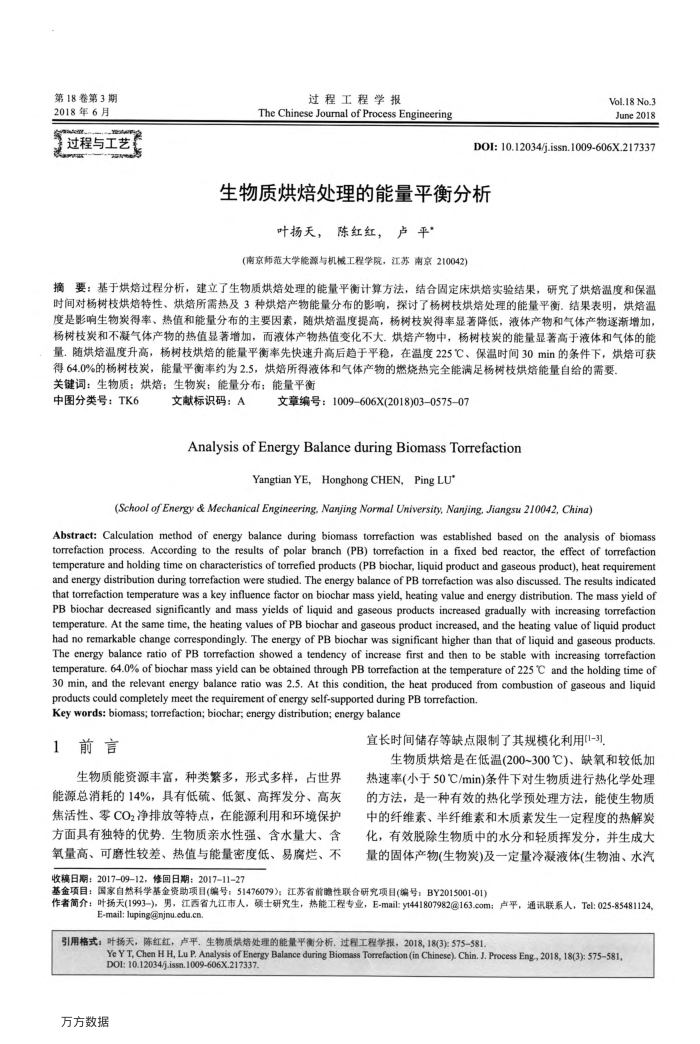您当前的位置:首页>论文资料>生物质烘焙处理的能量平衡分析
内容简介
 81 2018年6月
81 2018年6月过程与工艺
过程工程学报
The Chinese Jourmal of Process Engineering
Vol.18 No.3 June2018
DOI: 10.12034/j.issn.1009-606X.217337
生物质烘焙处理的能量平衡分析
叶扬天,陈红红,卢平
(南京师范大学能源与机械工程学院,江苏南京210042)
摘要:基于烘焙过程分析,建立了生物质烘焙处理的能量平衡计算方法,结合固定床烘焙实验结果,研究了烘焙温度和保温时间对杨树枝烘焙特性、烘焙所需热及3种烘焙产物能量分布的影响,探讨了杨树枝烘焙处理的能量平衡.结果表明,烘焙温度是影响生物炭得率、热值和能量分布的主要因素,随烘焙温度提高,杨树枝炭得率显著降低,液体产物和气体产物逐渐增加,杨树枝炭和不凝气体产物的热值显著增加,而液体产物热值变化不大。烘焙产物中,杨树枝炭的能量著高于液体和气体的能量.随烘焙温度升高,杨树枝烘焙的能量平衡率先快速升高后趋于平稳,在温度225℃、保温时间30min的条件下,烘熔可获得64.0%的杨树枝炭,能量平衡率约为2.5,烘焙所得液体和气体产物的燃烧热完全能满足杨树枝烘焙能量自给的需要
关键词:生物质;烘焙;生物炭;能量分布;能量平衡中图分类号:TK6
文献标识码:A
文章编号:1009-606X(2018)03-0575-07
AnalysisofEnergyBalanceduringBiomassTorrefaction
Yangtian YE,Honghong CHEN,Ping LU*
(School of Energy & Mechanical Engineering, Nanjing Normal University, Nanjing. Jiangsu 210042, China)
Abstract: Calculation method of energy balance during biomass torrefaction was established based on the analysis of biomass torrefaction process. According to the results of polar branch (PB) torrefaction in a fixed bed reactor, the effect of torrefaction temperature and holding time on characteristics of torrefied products (PB biochar, liquid product and gaseous product), heat requirement and energy distribution during torrefaction were studied. The energy balance of PB torrefaction was also discussed. The results indicated that torrefaction temperature was a key influence factor on biochar mass yield, heating value and energy distribution. The mass yield of PB biochar decreased significantly and mass yields of liquid and gaseous products increased gradually with increasing torrefaction temperature. At the same time, the heating values of PB biochar and gaseous product increased, and the heating value of liquid product asaeeneaeaseeaaodoaea The energy balance ratio of PB torrefaction showed a tendency of increase first and then to be stable with increasing torrefaction temperature. 64.0% of biochar mass yield can be obtained through PB torrefaction at the temperature of 225 C and the holding time of 30 min, and the relevant energy balance ratio was 2.5. At this condition, the heat produced from combustion of gaseous and liquid
products could completely meet the requirement of energy self-supported during PB torrefaction. Key words: biomass; torrefaction; biochar; energy distribution; energy balance
1
前言
生物质能资源丰富,种类繁多,形式多样,占世界
能源总消耗的14%,具有低硫、低氮、高挥发分、高灰焦活性、零CO2净排放等特点,在能源利用和环境保护方面具有独特的优势.生物质亲水性强、含水量大、含氧量高、可磨性较差、热值与能量密度低、易腐烂、不
宜长时间储存等缺点限制了其规模化利用[1-3]
生物质烘焙是在低温(200~300℃)、缺氧和较低加热速率(小于50℃/min)条件下对生物质进行热化学处理的方法,是一种有效的热化学预处理方法,能使生物质中的纤维素、半纤维素和木质素发生一定程度的热解炭化,有效脱除生物质中的水分和轻质挥发分,并生成大量的固体产物(生物炭)及一定量冷凝液体(生物油、水汽
收稿日期:20170912,修回日期;20171127
基金项目:国家自然科学基金资助项目(编号:51476079):江苏省前瞻性联合研究项目(编号:BY2015001-01)
作者简介:叶扬天(1993-),男,江西省九江市人,硕士研究生,热能工程专业,E-mail:yt441807982@163.com:卢平,通讯联系人,Tel:025-85481124
E-mail: lupingnjnu.edu.cn.
引用格式:叶扬天,陈红红,卢平,生物质烘焙处理的能量平衡分析,过程工程学报,2018,18(3):575-581
Ye Y T, Chen H H, Lu P. Analysis ofEnergy Balance during Biomass Torrefaction (in Chinese), Chin. J. Process Eng, 2018, 18(3): 575581, DOI: 10.12034/j.issn.1009-606X.217337.
万方数据